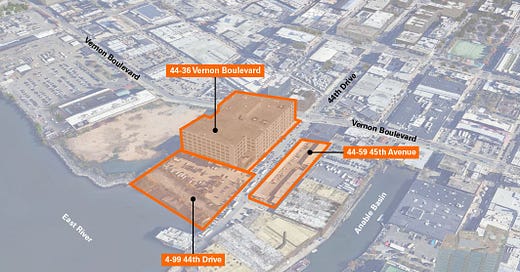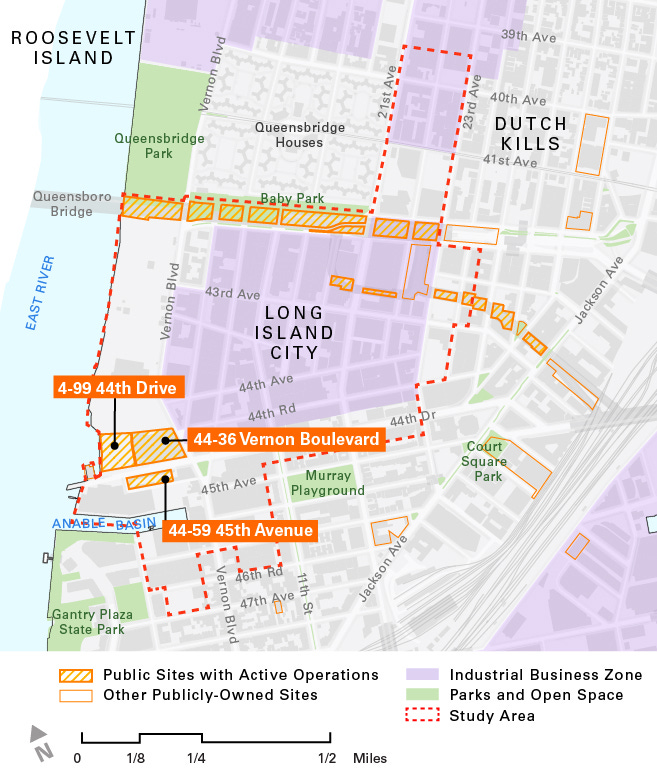One LIC Public Sites Workshop
Reimagining Long Island City's city-owned properties for community benefit
Last month, the One LIC neighborhood plan team held a public sites workshop aimed at reimagining and revitalizing public spaces in Long Island City. The workshop focused on city-owned sites, particularly those around the the waterfront, with the goal of transforming underutilized or outdated spaces into vibrant, community-serving areas. The event involved multiple city agencies, local stakeholders, and residents, and was designed to solicit feedback and build consensus around a shared vision for the neighborhood’s future.
Some background— If you’ve been reading my Substack, you probably already know that the One LIC initiative is a holistic planning effort that seeks to address the needs of the neighborhood through a combination of zoning changes, infrastructure improvements, and community-driven priorities. The plan is divided into two key areas: the study area, which includes the specific sites being considered for land use changes, and the context area, which encompasses the broader surrounding region for analysis.
The workshop highlighted three key city-owned public sites in the study area that are central to the redevelopment efforts. These sites, currently used by the Department of Transportation (DOT), Department of Education (DOE), and Small Business Services (SBS), include 44-59 45th Ave, 4-88 44th Dr, and 44-46 Vernon Blvd. Each site presents unique opportunities and challenges:
The 44-59 45th Ave site, a 47,000-square-foot parcel owned and used by DOT, offers potential for new housing, retail, and/or community facilities.
The 4-88 44th Dr site, a 160,000-square-foot lot owned by SBS and used by DOE, is primarily used for parking but could be redeveloped for more active uses.
The 44-46 Vernon Blvd site, a 104,000-square-foot property dominated by a 672,000-square-foot warehouse building, is currently used by DOE for storage, warehousing, and offices. The building is structurally divided into two independent halves, which could allow for partial redevelopment or adaptive reuse.
One of the most significant challenges discussed during the workshop is the relocation of existing operations currently housed on these sites. Both DOE and DOT use these spaces for critical functions, and finding suitable alternatives will be a complex and costly process. Additionally, the redevelopment of these sites will require significant investment in environmental remediation, sewer infrastructure, street grade changes, and resiliency improvements. For example, the Vernon Blvd building, which is largely used as a warehouse, would require extensive and costly renovations to make it suitable for housing or other uses. Estimates suggest that the cost of converting this building could reach hundreds of millions of dollars, comparable to constructing a new building from scratch. Adam Meagher, Senior Vice President for Neighborhood Strategies at the NYC Economic Development Corporation, explained that these estimates are based on the city’s experience with similar projects and take into account the need for demolition, environmental remediation, and infrastructure upgrades.
Despite these challenges, the workshop highlighted numerous opportunities for transforming these public sites into assets that serve the community. Proposed zoning changes in the One LIC plan would allow for higher-density, mixed-use buildings along the waterfront, with a requirement for continuous public open space along the shoreline. Through surveys and public input, residents have expressed strong interest in affordable housing, with many advocating for 100% affordable units on these sites. There is also significant demand for affordable arts and artist studio spaces, as well as community-focused programming and facilities. Other priorities include resilient infrastructure, mixed-use development (housing, schools, retail, and/or community facilities), and activating the waterfront with new public open spaces.
A public survey is currently open for community input, allowing residents to share their priorities and ideas for the future of these public sites. This spring, the city also plans to release a Request for Expressions of Interest (RFEI), inviting proposals from developers, organizations, and other stakeholders to redevelop or adaptively reuse these sites. Responses to the RFEI will inform the subsequent Request for Proposals (RFP), which will outline the final development plans.





